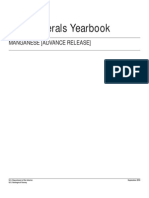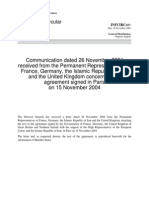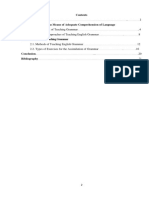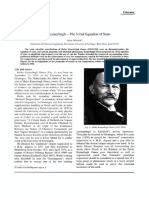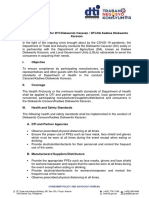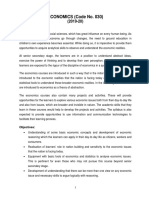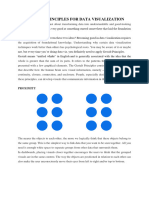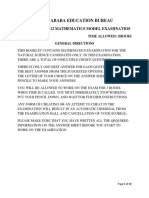The Mineral History of Italy
The Mineral History of Italy
Uploaded by
420Copyright:
Available Formats
The Mineral History of Italy
The Mineral History of Italy
Uploaded by
420Copyright
Available Formats
Share this document
Did you find this document useful?
Is this content inappropriate?
Copyright:
Available Formats
The Mineral History of Italy
The Mineral History of Italy
Uploaded by
420Copyright:
Available Formats
THE MINERAL INDUSTRY OF
ITALY
By Harold R. Newman
With the exception of industrial minerals, Italy has few The Government is continuing to examine its 2000-to-
natural resources. Deposits of coal, iron, and petroleum are 2004 incentive program to foster the use of environment-
not substantial. Estimates of natural gas reserves, which are friendly vehicles. The Government is providing funds to local
located mainly in the Po Valley and offshore Adriatic Sea, governments of cities of more than 150,000 people for the
have increased in recent years, and the reserves constitute an purchase of natural gas-powered vehicles to reduce emissions
important mineral resource (Wikipedia Co., 2002§1). (Scmuckal, 2002§).
Italy has been a significant processor of imported raw
materials and a significant consumer and exporter of mineral Production
and semimanufactured and finished metal products. Italy was
a significant producer of dimension stone, feldspar, marble, Among the metallic ores, lead, silver, and zinc were mined;
and pumice. In terms of world production, the country was a the outputs of these ores, however, were not significant. Gold
significant producer of cement and crude steel. was produced by one company (table 1).
The country has a surface area of 301,000 square kilometers. Industrial mineral production, which included construction
In 2002, the gross domestic product (GDP) in purchasing power materials, was the most important sector with overall output
parity was $1,510 billion, and GDP per capital income was remaining about the same as that of 2001 (table 1). Domestic
$26,266. The unemployment rate was 9 percent (International production of natural gas and petroleum continued as in 2002.
Monetary Fund, 2004§). Indices of production are listed in table 2.
Private and public companies owned facilities for the mining
Government Policies and Programs and processing of minerals and mineral products. Some
enterprises were under State control for such economic reasons
Italy was one of the 11 founding members of the European as to maintain employment (table 3).
Economic and Monetary Union and was the world’s sixth largest
economy in 2002. The Government has traditionally played a Commodity Review
dominant role in the economy through regulation of ownership
of large industrial and financial companies. Privatization and Metals
regulatory reform since 1994 have reduced that presence. The
Government, however, has retained a potentially blocking Bauxite and Alumina.—Euroallumina S.p.A. was an
“golden share” in all the industrial companies that have been international joint venture that operated a plant that produces
privatized thus far (U.S. Department of State, 2002, p. 6). alumina from bauxite by using the Bayer process; the plant was
located at Portoscuso in the Sulcis Iglesiente region of Sardina.
Environmental Issues In 2002, Eurallumina operated at close to its capacity of 1 million
metric tons per year (Mt/yr) for Cominco Ltd. (56.2%) and
Italy focused on three main areas—air pollution, water Glencore AG (43.8%), which were the joint-venture participants
pollution, and environmental laws. The primary source of air that took the product in proportion to their shares in the
pollution in Italy is gasoline-powered motor vehicles. Italy consortium. The bauxite feed material was supplied by Comalco’s
has one of the highest per-capita levels of car ownership in the Wiepa Mine in Australia (Eurallumina S.p.A., 2002§).
world. The Government has taken steps to reduce vehicle traffic
Copper.—The largest producer of refined copper in Italy
by offering a “car-free” Sunday. The first Sunday this was
SIMAR S.p.A. accounted for about one-half of Italy’s copper
offered, the benzene levels in the air in Milan dropped by 40%
output. Italy’s refined copper production was reflected in the
(Scmuckal, 2002§).
availability and cost of scrap material. Copper mines in Italy
Preventing water pollution has been difficult owing to severe
were not significant, and imports of ore were small.
incidents like the spill of pollutants in the Adriatic Sea. Law 36,
which consolidates management of the water cycle (fresh water Gold.—Gold Mines of Sardinia Ltd. (GMS), which was
supply and wastewater treatment), has been implemented. It a joint venture of Gold Mines of Sardinia Ltd. (70%) and
restructured the regional management of water resources and Progemisa S.p.A. (30%), operated the Furtei Mine, which is
allows local governments to set user charges (Scmuckal, 2002§). located north of Cagliari. Furtei was the first gold mine of GMS
and the first gold mine in Italy.
1
Exploration results during 2002 included a major review of
References that include a section mark (§) are found in the Internet
References Cited section.
exploration data at Furtei and two geophysical surveys designed
THE MINERAL INDUSTRY OF ITALY—2002 14.1
to locate gold mineralization at depth within the Furtei Mine Lime.—The Italian lime industry had a quicklime
corridor. GMS reported that this work had identified a number production of about 1.6 Mt/yr. Most of the lime production
of prospective targets that would be drill tested in 2003 (Gold was concentrated in the region of Lombardy. Unicale was the
Mines of Sardinia plc, 2003§). leading producer.
GMS formalized its agreement with Barrick Gold Corp. of The lime market in Europe had a strong interest in the use
Canada to explore the area around Monte Ollasteddu where of a cost-effective fuel. Dual-fuel combustion equipment was
they had found a deposit with high-grade mesothermal gold and installed in the Calce San Pellegrino plant of Cimprogetti S.p.A.
arsenopyrite that outcrops over an area of 3.5 kilometers (km) The kilns had the capability to operate at 100% pulverized
by 1 km with the potential for an open pit operation. The other petcoke, 100% natural gas, or a combination of both fuels in any
focus was on the Torpe prospect, which is located in the north prefixed ratio. This allowed maximum operational flexibility
of the island and has similar geological structures to Monte and reduced operating costs (World Cement Review, 2003).
Ollestaddu. Stream sediment sampling identified a 16-km-long
gold anomalous zone. A number of channels samples were Potash.—Production of potash remained suspended in 2002.
reported to have high gold grades (Minesite, 2002§). The main reasons were the restricted availability of ground
water owing to a severe drought and the inability to remove
Iron and Steel.—Acciaierie e Ferriere Vicentine Beltrame waste material and mine water owing to environmental and
S.p.A. (AFV-Beltrame) was to buy two steelworks from ecological concerns. In Sicily, the underground mines that
Siderugica Ferrero S.p.A. in 2002. The San Didero minimill, had been operating at Pasquasia, Racalmuto, and Realmonte
which is located near Turin, had a capacity of about 1 Mt/yr; remained on care-and-maintenance status.
the San Giovanni Valdarno light section mill, which is located
near Florence, had a capacity of about 230,000 metric tons per Pumice and Pumicite.—Italy was a significant producer
year (t/yr). The plants’ products included reinforcing bars, flats, of pumice and pozzolan. The Mediterranean island of Lipari,
angles, squares, tees, and sections up to 140 millimeters. The which is located 40 km off the northern coast of Sicily, was the
acquisitions would raise AFV-Beltrame’s production capacity to center of the Italian pumice industry. Pumex S.p.A. and Sta
more than 2.5 Mt/yr (Metal Bulletin, 2002). Siciliana per I’Industria ed il Commercio della Pomice di Lipari
S.p.A. (Italpomice S.p.A.) quarried pumice for world markets.
Lead and Zinc.—Italy imported most of its requirements Pumex, which had a capacity of about 600,000 t/yr, was Italy’s
for lead and zinc concentrates. Within Italy, the small amount largest pumice producer. The company quarried the Mount
of lead and zinc concentrate production came from mines in Pelato deposit on Lipari (Pumex S.p.a., 2002§).
Sardinia.
Stone, Dimension.—Marble occurs in many localities from
Industrial Minerals the Italian Alps to Sicily and was quarried at hundreds of
operations. The most important geographic area for producing
Bauxite and Alumina.—Italy’s only bauxite producer white marble is in the Apuan Alps in Tuscany, particularly near
Sardabauxiti S.p.A. mined the Olmedo karst bauxite deposit, the town of Carrara. Lombardy, the Po Valley, Puglia, Sicily
which is largely boehmitic and contains less than 5% diaspore. (island), and Verona-Vincenza are important colored-marble-
The company produced an estimated 300,000 t/yr of abrasive, producing areas. About one-half of the production was in block
cement, and slag adjuster grades of bauxite. form. Other major marble-producing areas include the Valle di
Susa, which is located near Benevento and Turin.
Cement.—Italy was the second largest cement producer
in the European Union (EU), after Germany. Italcementi Mineral Fuels
Fabbriche Riunite Cemento S.p.A. was the largest of Italy’s
cement producers with 22 plants and 55 quarries. Italy was a Italy was almost entirely dependent on imports to meet its
net exporter of cement (Italcementi Group, 2002b§). energy needs. The country’s heavy reliance on foreign oil and
Calcestruzzi SpA (a subsidiary of Italcementi) and Unicale gas sources, such as Algeria and Libya, made energy security
SpA (a Buzzi Unicem Group subsidiary) signed a contract and diversification of energy sources a top concern (U.S. Energy
with the Turin-Milan High Speed Rail Link Consortium for Information Administration, 2003§).
the supply of ready-mixed concrete for the first stage of the The operational launch of the Italy-Greece interconnector
Turin-Milan high-capacity railway from Turin to Novarra. electric line was a significant step in the creation of a single
The contract provided for the supply of about 2 million metric European energy market that would form a mutually beneficial
tons of ready-mixed concrete during the next 3 years and was bridge between southeastern and western Europe. A 163-km-
worth almost $200 million; Unicale was to receive 51%, and long underwater cable linked plants in Arachtos, Greece, and
Calcestruzzi, 49% (Italcementi Group, 2002a§). Galatina, Italy. At some points, it was laid at a depth of 1,000
meters; this was a record for underwater cables. Its cost was
Gypsum.—The gypsum processing plant of Fassa S.r.l., more than $375 million; the EU underwrote 40% of the total
which opened in mid-2001, continued burning and processing (Alexander’s Gas & Oil Connections, 2002a§).
the gypsum extracted from a nearby quarry. The plant was
completely automatic from the discharge of raw gypsum to the Coal.—Italy was heavily dependent on imported coal. Most
bagging of the finished product. imports were from, in declining order of importance, Russia,
14.2 U.S. GEOLOGICAL SURVEY MINERALS YEARBOOK—2002
South Africa, the United States, and China. Coal consumption Italy is expected to continue to be the world’s leading producer
in Italy was dominated by power generation, which was of feldspar, feldspathic minerals, and pumice.
increasing, and coke production for steel, which was decreasing. Domestic outputs of natural gas, crude petroleum, and
About 6% of Italy’s primary energy demand was met with coal petroleum refinery products are expected to grow, although Italy
(U.S. Energy Information Administration, 2003§). will continue to depend on imported coal, gas, and petroleum
Lignite was produced by Ente Nazional per l’Energia for most of its needs.
Electrica’s Santa Barbara Mine in Tuscany, which was the only
lignite mine in Italy. References Cited
Geothermal Energy.—Geothermal energy was produced in Metal Bulletin, 2002, Ferrero deal consolidates Beltrame’s position as Europe’s
the Larderello, Monte Amiata, and Travale areas in Tuscany. top merchant bar producer: Metal Bulletin, no. 8644, January 28, p. 3.
U.S. Department of State, 2002, Italy—2001 country report on economic policy
Exploration that used various geologic techniques have been and trade practices: U.S. Department of State, Bureau of Economic and
actively pursued in these areas and research for power stations Business Affairs, February, 21 p.
that exploit geothermal energy. World Cement Review, 2003, Dual fuel: World Cement Review, v. 34, no. 4,
April, p. 91.
Natural Gas and Petroleum.—BG Italia S.p.A, Edison
S.p.A, and Ente Nazional Idrocorburi (ENI) announced that they Internet References Cited
had discovered a significant deposit of natural gas after drilling
the Panda 1 exploration well. ENI reported that production tests Alexander’s Gas & Oil Connections, 2002a (October), Italy-Greece
interconnector launched, accessed December 27, 2002, at URL
indicated gas reserves that ranged from about 9 billion to 12 http://www.gasandoil.com/goc/news/nte24641.htm.
billion cubic meters with a possibility of 24 billion to 30 billion Alexander’s Gas & Oil Connections, 2002b (May), Italy has the most expensive
cubic meters of reserves after additional drilling. This would wind power in Europe, accessed May 6, 2002, at URL
make the deposit one of the largest natural gas fields in Italy. http://www.gasandoil.com/ goc/news/nte21547.htm.
Alexander’s Gas & Oil Connections, 2002c (May), New gas discovery in Sicily
The partners were conducting seismic activities and planned Channel, accessed May 6, 2002, at URL http;//www.gasandoil.com/goc/
to drill a second exploration well (Alexander’s Gas & Oil discover/dix21818.htm.
Connections, 2002b§). Eurallumina S.p.A., 2002, The company, accessed September 15, 2003, at URL
http://www.eurallumina.com/sommarioeng.htm.
Renewable Energy.—Wind generation was gaining Gold Mines of Sardinia plc, 2003, Gold Mines of Sardinia plc—Exploration
2002, accessed August 22, 2003, at URL http://www.gmsplc.com/exploration.
importance in European power markets as a number of countries htm.
began to invest in the technology. Italy had the most expensive International Monetary Fund, 2004, World economic outlook database, accessed
wind power in the EU. Italian wind power cost a minimum of May 27, 2004, at URL http://www.imf.org/external/pubs/ft/weo/2004/01/data/
$0.14 per kilowatt hour (kWh). Germany was the second most dbcoutm.cfm.
Italcementi Group, 2002a (September), High speed rail link, accessed
expensive, at a minimum of $0.13 per kWh, and Ireland had July15, 2002, at URL http://www.italcementigroup.com/newsite/download/
the least expensive costs at a minimum price of $0.04 per kWh ar2002/ITC_Buzzi_calcestruzzo_eng.pdf.
(Alexander’s Gas & Oil Connections, 2002c§). Italcementi Group, 2002b, Profile of Italcementi Group in Italy, accessed
Despite increasing domestic production of crude oil, Italy was July 15, 2002, at URL http://www.ccb.be/about/group/italy_en.htm.
Minesite, 2002 (May 2), Gold Mines of Sardinia expects to start drilling in joint
less than 20% self-sufficient in energy. Italy’s oilfields are in venture with Barrick, accessed December 16, 2002, at URL http://www.
the north of the country, onshore and offshore along the Adriatic minesite.com/archives/news_archives2002/may_2002/sardinia020502.htm.
Sea, and onshore and offshore Sicily. Production from two Pumex S.p.a., 2002, The role of a leader, accessed January 30, 2003, at URL
large fields, Aquila and Villafortuna, declined in recent years. http://www.pumex.it/ uk/home.html.
Scmuckal, Kelly, 2002 (June), Italy’s environmental struggle, accessed
Italy’s largest integrated oil company ENI was in the process July 30, 2003, at URL http://www.alma.edu/academics/polsci/payerhin/
of developing a 600-million-barrel-equivalent oil field at Val Ppr1-211-01/schmuckal.htm.
d’Agri in the southern Appennine region. This was considered U.S. Energy Information Administration, 2003 (March), Italy, Country Analysis
to be Europe’s most promising onshore development area (U.S. Brief, accessed August 29, 2003, at URL http://www.eia.doe.gov/emeu/cabs/
italy2.html.
Energy Information Administration, 2003§). Wikipedia Co., 2002, Economy of Italy, accessed September 24, 2002, at URL
http://www.wikipedia.org/w/wiki.phtml?title=Economy_0f_Italy&printable=yes.
Outlook
Major Sources of Information
Mining of metallic ores is expected to remain at its low levels
because of ore depletion and will eventually cease altogether. Associazione Mineraria Italiana
The metals-processing industry, which is based primarily on Via delle Madonne, 20
imported raw materials, is expected to continue to play an 00197 Rome, Italy
important role in Italy’s economy. Italy is expected to remain Ministero dell’Industria del Commercio e dell’Artigianato
a large producer of crude steel and a significant producer of Direzione Generale delle Minire
secondary aluminum in the EU. Via Molise, 2
The industrial minerals quarrying industry and preparation 00184 Rome, Italy
plants are expected to remain significant, especially in the
production of barite, cement, clays, fluorspar, marble, and talc.
THE MINERAL INDUSTRY OF ITALY—2002 14.3
TABLE 1
ITALY: PRODUCTION OF MINERAL COMMODITIES1
(Metric tons unless otherwise specified)
Commodity 1998 1999 2000 2001 2002e
METALS
Aluminum:
Alumina, calcined basise 930,000 973,000 950,000 950,000 925,000
Metal:
Primary 186,953 187,281 189,800 187,400 190,000
Secondary 502,600 501,800 657,500 574,900 590,000
Total 689,553 689,081 847,300 762,300 780,000
Antimony oxides, gross weighte, 2 700 600 600 600 500
Bismuth metale 5 5 5 5 5
Cadmium metal, smelter 328 360 284 313 390
Copper, metal, refined, all kindse 29,100 28,500 72,800 35,500 32,400
Gold, Au content kilograms 500 600 791 503 600
Iron and steel, metal:
3
Pig iron thousand tons 10,704 10,622 11,219 10,650 9,736
Ferroalloys, electric furnace:
e
Ferrochromium 11,487 -- -- -- --
e
Ferromanganese 49,000 19,000 40,000 40,000 40,000
Ferrosilicone 12,000 12,000 12,000 12,000 12,000
e
Silicomanganese 70,000 67,000 90,000 80,000 80,000
r
Silicon metal 8,094 6,257 5,000 5,978 6,000
Othere 10,000 10,000 10,000 10,000 10,000
r
Total 160,581 114,257 157,000 147,978 148,000
Steel, crude thousand tons 25,826 24,964 26,475 25,483 25,930
Lead:
3
Mine output, Pb contente 6,800 6,000 2,000 1,000 500
Metal, refined:
e e
Primary 57,400 66,954 75,000 82,000 45,000
e e
Secondary 141,900 148,354 160,000 121,000 150,000
e e
Total 199,300 215,308 235,000 203,000 195,000
Manganese, mine output, Mn contente 1,440 1,200 12,000 1,000 500
e e
Silver, metal kilograms 2,500 4,000 4,000 3,500 3,500
Zinc:
e
Mine output, Zn content 2,459 -- -- -- --
Metal, primary 231,600 145,318 170,300 177,800 176,000
INDUSTRIAL MINERALS
Baritee 36,000 30,000 30,000 30,000 30,000
Bauxitee 300 300 300 300 300
Brominee 300 300 300 300 300
Cement, hydraulic thousand tons 36,222 37,391 39,020 39,885 40,000
Clays, crude:e
3 3
Bentonite do. 592 600 600 600 600
Refractory excluding kaolinitic earth do. 750 700 700 700 700
Fuller's earth do. 30 30 30 30 30
Kaolin do. 100 100 100 100 100
Kaolinitic earth do. 10 10 10 10 10
Diatomitee 25,000 25,000 25,000 25,000 25,000
3
Feldspare 2,748 2,700 2,500 2,500 2,500
Fluorspar:e
Acid-grade 92,000 95,000 50,000 30,000 30,000
Metallurgical-grade 15,000 15,000 15,000 15,000 15,000
Total 107,000 110,000 65,000 45,000 45,000
Gypsume thousand tons 1,300 1,300 1,200 1,200 1,200
Lime, hydrated, hydraulic and quicklimee do. 3,500 3,500 3,500 3,500 3,500
3
Nitrogen, N content of ammonia do. 409 367 408 434 391
Perlitee 60,000 60,000 60,000 60,000 60,000
Pigments, mineral, iron oxides, naturale 500 500 500 500 500
See footnotes at end of table.
14.4 U.S. GEOLOGICAL SURVEY MINERALS YEARBOOK—2002
TABLE 1--Continued
ITALY: PRODUCTION OF MINERAL COMMODITIES1
(Metric tons unless otherwise specified)
Commodity 1998 1999 2000 2001 2002e
INDUSTRIAL MINERALS--Continued
Pumice and related materials:e
Pumice and pumiceous lapilli thousand tons 600 600 600 600 600
Pozzolan do. 4,000 4,000 4,000 4,000 4,000
Salt:e
Marine, crude4 do. 600 600 600 600 600
Rock and brine do. 3,300 3,200 3,200 3,200 3,200
Sand and gravel:e
Volcanic sand do. 100 100 100 100 100
Silica sand do. 300 300 300 300 300
Other sand and gravel 100,000 100,000 100,000 100,000 100,000
Sodium compounds, n.e.s.:e
Soda ash thousand tons 1,000 1,000 1,000 100 100
Sodium sulfate do. 125 125 125 125 125
Stone:
Calcareous:
Alabaster do. 25 25 25 25 25
Marble in blocks:
White do. 100 100 100 100 100
Colored do. 3,000 3,000 3,000 3,000 3,000
Travertine do. 2,500 2,500 2,500 2,500 2,500
Other:
Granite do. 100 100 100 100 100
Sandstone do. 1,800 1,800 1,800 1,800 1,800
Slate do. 100 100 100 100 100
Crushed and broken:
Dolomite do. 711 700 700 700 700
Limestone do. 120,000 120,000 120,000 120,000 120,000
Marl for cement do. 15,000 15,000 14,000 14,000 14,000
Serpentine do. 1,500 1,500 1,500 1,500 1,500
Quartz and quartzite do. 30 30 30 30 30
Sulfur, recovered as elemental, in compounds, do. 624 678 693 743 725
byproducts, other sources
Talc and related materialse 138,000 140,000 140,000 140,000 135,000
MINERAL FUELS AND RELATED MATERIALS
Asphalt and bituminous rock, naturale 30,000 30,000 30,000 30,000 25,000
Coal:
Lignite thousand tons 156 19 14 10 10
Subbituminous, Sulcis coale 10 5 5 5 5
r
Coke, metallurgical thousand tons 3,500 4,825 5,264 4,829 5,200
3
Gas, naturale million cubic meters 19,000 18,500 18,500 18,000 18,000
Natural gas liquidse thousand 42-gallon barrels 400 350 350 350 350
Petroleum:
3
Crude do. 42,923 34,245 35,000 35,000 25,650
Refinery products:
e
Liquefied petroleum gas do. 25,750 25,404 27,446 27,000 27,000
e
Gasoline do. 173,264 174,063 175,576 175,000 175,000
e e
Naphtha do. 37,341 30,209 30,000 30,000 30,000
Jet fuele do. 25,000 25,000 36,440 36,000 36,000
Kerosenee do. 30,000 30,000 15,000 15,000 15,000
e
Distillate fuel oil do. 271,910 271,820 262,226 262,000 262,000
e
Residual fuel oil do. 114,226 104,948 100,459 100,000 100,000
e
Other do. 38,850 42,042 46,137 46,000 46,000
e e
Refinery fuel and losses do. 1,568 1,778 1,700 1,700 1,700
Totale do. 718,000 705,000 695,000 693,000 693,000
See footnotes at end of table.
THE MINERAL INDUSTRY OF ITALY—2002 14.5
TABLE 1--Continued
ITALY: PRODUCTION OF MINERAL COMMODITIES1
e
Estimated; estimated data are rounded to no more than three significant digits; may not add to total shown. rRevised. -- Zero.
1
Table includes data available through September 2003.
2
Reported figure.
3
Antimony content is 83% of gross weight.
4
Does not include production from Sardinia and Sicily, which was estimated to be 200,000 metric tons per year.
5
Output of limestone and serpentine for dimension stone is included with "Stone: Crushed and broken." In addition to the commodities listed, a variety of other
dimension stone was produced and previously listed, but available general information was inadequate for continued reliable estimates of output levels
TABLE 2
ITALY: SELECTED INDICES OF PRODUCTION
(1995 = 100)
Sector 1998 1999 2000 2001 2002
General 104.3 104.4 107.7 106.8 105.3
Mining 107.9 107.8 98.4 90.8 104.4
Manufacturing 103.9 103.6 106.7 105.8 103.7
Electricity and gas 107.3 111.4 118.3 117.2 120.8
Source: United Nations, 2003, Monthly Bulletin of Statistics, v. LVII, no. 984, June, p. 16.
TABLE 3
ITALY: STRUCTURE OF THE MINERAL INDUSTRY IN 2002
(Thousand metric tons unless otherwise specified)
Major operating companies Annual
Commodity and major equity owners Location of main facilities capacity
Alumina Eurallumina S.p.A. (Comalco Ltd., 56.2%, and Plant at Portoscuso, Sardinia 1,000
Glencore AG, 43.8%)
Aluminum Alcoa Italia S.p.A. (Alcoa Inc., 100%) Smelters at Porto Vesme, Sardinia, and Fusina, near Venice 188
Asbestos Amiantifera di Balangero S.p.A. Mine at Balangero, near Turin 100
Barite Bariosarda S.p.A (Ente Mineraria Sarda) Mines at Barega and Mont 'Ega, Sardinia 100
Do. Edem S.p.A. (Government) Mines at Val di Castello, Lucca 20
Do. Edemsarda S.p.A. (Soc. Imprese Industriali) Mines at Su Benatzu, Sto Stefano, and Peppixeddu, Sardina
Do. Mineraria Baritina S.p.A Mines at Marigolek, Monte Elto, and Primaluna, near Milan 20
Bauxite Sardabauxiti S.p.A. (Cogein S.p.A., 40%; Comtec, Mine at Olmedo, Sardinia 350
40%; Icofin Co., 20%)
Bentonite Industria Chimica Carlo Laviosa S.p.A Mines and plant on Sardinia Island, and a plant near Pisa 250
Cement 52 companies, of which the largest are:
Do. Italcementi Fabbriche Riunite Cemento S.p.A. 22 plants, of which the largest are Calusco, Monselicem and 15,000
Collefero
Do. Buzzi Unicem Group 12 plants, of which Guidonia, Lugagnano, Morano, Piacenza, 10,000
S'Arcangelo di Romagna, and Settimello are the largest
Do. Cementerie del Tirreno S.p.A (Cementir) Six plants at Arquasta Scivia, Livorno, Maddaloni, Napoli, 5,300
Spoleto, and Taranto
Copper, refined SIMAR SpA Refinery at Porto Marghera (closed) 60
Do. Europa Metalli - LMI S.p.A. Refinery Fornaci di Barga 24
Do. SITI Industries Refinery at Pieve Vergonte 30
14.6 U.S. GEOLOGICAL SURVEY MINERALS YEARBOOK—2002
TABLE 3--Continued
ITALY: STRUCTURE OF THE MINERAL INDUSTRY IN 2002
(Thousand metric tons unless otherwise specified)
Major operating companies Annual
Commodity and major equity owners Location of main facilities capacity
Feldspar At least five companies, of which the largest are: 1,500
Maffei S.p.A. Surface mines at Pinzolo, Sondalo, and Campiglia Marittima (200)
Do. do. Underground mine at Vipiteno (300)
Do. Miniera di Fragne S.p.A. Surface mine at Alagna Valsesia (60)
Do. Sabbie Silicee Fossanova S.P.A. (Sasifo) Surface mine at Fossanova (30)
Gold kilograms Gold Mines of Sardinia Ltd., 70%; Furtei Mine near Cagliaria, Sardinia 1,400
Progemisa S.p.A., 30%
Gypsum Fassa S.r.l. Plant at Moncalvo, Asti 90
Lead, metal Glencore AG Refinery at San Gavino, Sardinia 100
Do. do. Kivcet smelter and Imperial smelter at Porto Vesme, Sardinia 35
Lignite Ente Nazional per l'Energia Electtrica (ENEL) Surface mine at Santa Barbara 1,000
Lime Unicale S.p.A. Plants in Lombardy region 500
Magnesium, metal Societa Italiana Magnesio S.p.A. (INDEL) Plant at Bolzano 8
Marble A number of companies, the largest of which include: 2,000
Marble Mineraria Marittima Srl Quarries in the Carrara and Massa areas (500)
Do. Industria dei Marmi Vicentini S.p.A. do. (300)
Do. Figaia S.p.A. do. (100)
Nitrogen, N content of ammonia Hydro Agri SpA Plant at Ferrara 410
Petroleum, crude Ente Nazional Idrocarburi (ENI) (Government) Oilfields offshore Sicily and the Adriatic Sea, and 90
onshore in the Po River Valley
Petroleum, refined thousand do. About 30 refineries 2,000
42-gallon barrels per day
Potash ore Industria Sali Otassici e Affini per Aziono S.p.A. Underground mines at Corvillo, Pasquasia, Racalmuto, and 1,300
San Cataldo, in Sicily (closed)
Do. Sta Italiana Sali Alcalini S.p.A. (Italkali) Underground mines at Casteltermini and Pasquasia, 700
Sicily
Pumice Pumex S.p.A. Quarries, Lipari Island, north of Sicily 600
Do. Sta Siciliana per I'Industria ed il Commercio della do. 200
Pomice di Lipari S.p.A. (Italpomice S.p.A.)
Pyrite Nuova Solmine S.p.A. Underground mines at Campiano and Niccioleta 900
Salt, rock Sta Italiana Sali Alcalini S.p.A. (Italkahi) Underground mines at Petralia, Racalmuto, and Realmonte, 4,000
Sicily
Do. Solvay S.p.A. Underground mines at Buriano, Pontteginori, and Querceto, 2,000
Tuscany
Steel Ilva S.p.A. (Riva Group) 5 steel plants, the largest of which is Taranto (1,500) 4,000
Do. Riva Acciaio S.p.A. (Riva Group) 7 plants 7,000
Do. Acciaierie e Ferriere Vicentine Beltrame S.p.a. Steel plant at Vicenza 1,000
(AFV-Beltrame S.p.A.)
Talc Luzenac Val Chisone S.p.A. Mines at Pinerolo, near Turin, and at Orani, Sardinia 120
Do. Talco Sardegna S.p.A. Mine at Orani, Sardinia 20
Zinc, metal Glencore AG Plant at Porto Vesme, Sardinia 60
Do. Pertulosa Sud S.p.A. Plant at Crotone, Calabria 100
THE MINERAL INDUSTRY OF ITALY—2002 14.7
You might also like
- Collapse SACSDocument59 pagesCollapse SACSMurali Bharadwaj100% (1)
- Bonsai Elite WavetraderDocument64 pagesBonsai Elite Wavetradertthompson100% (4)
- HE Hilippines: by Travis Q. LydayDocument5 pagesHE Hilippines: by Travis Q. LydaybournetapsNo ratings yet
- The Mineral Industry ofDocument3 pagesThe Mineral Industry offwilliams31No ratings yet
- LithiumDocument3 pagesLithiumdougvspam92No ratings yet
- FeldsparDocument7 pagesFeldsparRiChy KantuNo ratings yet
- Iluka Pro Rata Entitlement Offer Appendix Mineral Sands Industry OverviewDocument16 pagesIluka Pro Rata Entitlement Offer Appendix Mineral Sands Industry OverviewGiang NguyenNo ratings yet
- Explanation Kyanite, Andalusite and Sillimanite in ProductionDocument5 pagesExplanation Kyanite, Andalusite and Sillimanite in ProductionSteven Luis Maiz CespedesNo ratings yet
- Ved 22Document19 pagesVed 22papiraniNo ratings yet
- Imerys To Buy Rio Tinto's LuzenacDocument3 pagesImerys To Buy Rio Tinto's Luzenac7kkqg42m6cNo ratings yet
- Myb1 2010 CobalDocument24 pagesMyb1 2010 Cobaljsalamanca calderonNo ratings yet
- Mining - Sector - Okitoi JosephDocument29 pagesMining - Sector - Okitoi JosephOkitoi JosephNo ratings yet
- The Beneficiation of Lithium Minerals From Hard Rock Ores A ReviewDocument15 pagesThe Beneficiation of Lithium Minerals From Hard Rock Ores A ReviewMaria José Futuro100% (1)
- Myb1 2015 CobalDocument20 pagesMyb1 2015 CobalFranco Vittorio Franchino CarrizoNo ratings yet
- Mangmyb 01Document15 pagesMangmyb 01Saad MotawéaNo ratings yet
- Auxite and Lumina: by Patricia A. PlunkertDocument10 pagesAuxite and Lumina: by Patricia A. PlunkertfrankieNo ratings yet
- Mgcommyb 03Document10 pagesMgcommyb 03sarpongbismark2003No ratings yet
- 2008 Minerals Yearbook: Ferroalloys (Advance Release)Document16 pages2008 Minerals Yearbook: Ferroalloys (Advance Release)böhmitNo ratings yet
- The Indian Mining Sector: Effects On The Environment & FDI InflowsDocument10 pagesThe Indian Mining Sector: Effects On The Environment & FDI InflowsMehul MandanakaNo ratings yet
- Energy Map Myb3 2011 Ga Pu SGDocument6 pagesEnergy Map Myb3 2011 Ga Pu SGBapsbabcar SowNo ratings yet
- Myb1-2006-Nickel by Peter H. KuckDocument27 pagesMyb1-2006-Nickel by Peter H. KuckAhmad AshariNo ratings yet
- Mineral Sands - May 2020Document20 pagesMineral Sands - May 2020Victor ChanNo ratings yet
- Underground Coal GasificationDocument5 pagesUnderground Coal GasificationshivaNo ratings yet
- India - Mineral Yearbook 2005Document15 pagesIndia - Mineral Yearbook 2005jfgarciadelrealNo ratings yet
- 2010 Minerals Yearbook: KenyaDocument5 pages2010 Minerals Yearbook: KenyaFrank LinNo ratings yet
- 2008 Minerals Yearbook: Manganese (Advance Release)Document23 pages2008 Minerals Yearbook: Manganese (Advance Release)Onizes Araujo JuniorNo ratings yet
- Study of Red Mud As An Alternative Building Material For Interlocking Block Manufacturing in Construction IndustryDocument6 pagesStudy of Red Mud As An Alternative Building Material For Interlocking Block Manufacturing in Construction IndustrySalahuddin QuadriNo ratings yet
- 2008 Minerals Yearbook: Antimony (Advance Release)Document9 pages2008 Minerals Yearbook: Antimony (Advance Release)Mikhail FedchikNo ratings yet
- 2005 Minerals Yearbook: IndiaDocument15 pages2005 Minerals Yearbook: Indiaminingnova1No ratings yet
- Auxite AND Lumina: by Patricia A. PlunkertDocument11 pagesAuxite AND Lumina: by Patricia A. Plunkertinfinity iNo ratings yet
- 2012 Minerals YearbookDocument10 pages2012 Minerals YearbookAfriandiBayuNo ratings yet
- 670400Document14 pages670400annishayNo ratings yet
- Dasar Dasar NikelDocument13 pagesDasar Dasar NikelEvangelista LindaNo ratings yet
- 2010 Minerals Yearbook: ZimbabweDocument9 pages2010 Minerals Yearbook: ZimbabweffgfgfgffgNo ratings yet
- Jurnal Red MudDocument12 pagesJurnal Red MudhellnaNo ratings yet
- Nickel and Cobalt Mining in PhilippinesDocument2 pagesNickel and Cobalt Mining in PhilippinesJunel AlapaNo ratings yet
- Mineral Wool Producers PDFDocument7 pagesMineral Wool Producers PDFZoltán BoérNo ratings yet
- Ilica: by Thomas P. DolleyDocument17 pagesIlica: by Thomas P. DolleyLubilo MateNo ratings yet
- A Study On The Ratio AnalysisDocument81 pagesA Study On The Ratio AnalysisSujay SuranNo ratings yet
- East Africa Mineral 1997Document6 pagesEast Africa Mineral 1997SENAITNo ratings yet
- Of Industrial Minerals in Mozambique byDocument18 pagesOf Industrial Minerals in Mozambique byGilart A C KerrNo ratings yet
- تكنولوجيا المعادن الصناعيه:Document24 pagesتكنولوجيا المعادن الصناعيه:ببجي ببجيNo ratings yet
- Myb3 2020 21 Republic KoreaDocument11 pagesMyb3 2020 21 Republic Koreaabbasfatimah2025No ratings yet
- Industry Profile: P G Department of Business AdministrationDocument69 pagesIndustry Profile: P G Department of Business AdministrationvinumarviNo ratings yet
- MiningDocument4 pagesMiningAIAH SEBBANo ratings yet
- AntimonyDocument4 pagesAntimonyabhay_pratap_2No ratings yet
- 6 MainDocument37 pages6 MainJayaprabhu PrabhuNo ratings yet
- Electro Smelting of IlmeniteDocument14 pagesElectro Smelting of IlmeniteRavi KiranNo ratings yet
- Geokniga Gold NevadaDocument151 pagesGeokniga Gold NevadaFAJJAR OKTAVIANTO OKTAVIANTONo ratings yet
- ETH, DJI, ERI, & SOM (East Africa Mineral 2002Document9 pagesETH, DJI, ERI, & SOM (East Africa Mineral 2002SENAITNo ratings yet
- Review of Industrial Minerals in MozambiqueDocument18 pagesReview of Industrial Minerals in MozambiqueYouzhnyNo ratings yet
- Production of Magnesium From Great Salt Lake Utah USADocument8 pagesProduction of Magnesium From Great Salt Lake Utah USAraminNo ratings yet
- SGLB022-Economic Geology 1-Industrial minerals notes-2020 (1)Document53 pagesSGLB022-Economic Geology 1-Industrial minerals notes-2020 (1)senzo.dlamini.2741No ratings yet
- Mine Wastes in Western Australia and Their Suitability For Embankment ConstructionDocument6 pagesMine Wastes in Western Australia and Their Suitability For Embankment ConstructionmohammedNo ratings yet
- Annual ReportDocument160 pagesAnnual Reportfarhan anwarNo ratings yet
- Orocco and Estern Ahara: by Philip A. SzczesniakDocument6 pagesOrocco and Estern Ahara: by Philip A. SzczesniakouarraqNo ratings yet
- Africa MineralDocument21 pagesAfrica MineralSENAITNo ratings yet
- Mineral and Energy Resources NotesDocument6 pagesMineral and Energy Resources Notesnairaditya0104No ratings yet
- Market Research, Global Market for Germanium and Germanium ProductsFrom EverandMarket Research, Global Market for Germanium and Germanium ProductsNo ratings yet
- Lead Smelting and Refining, With Some Notes on Lead MiningFrom EverandLead Smelting and Refining, With Some Notes on Lead MiningNo ratings yet
- Green energy? Get ready to dig.: Environmental and social costs of renewable energies.From EverandGreen energy? Get ready to dig.: Environmental and social costs of renewable energies.Rating: 5 out of 5 stars5/5 (1)
- Summary of Guillaume Pitron's The Rare Metals WarFrom EverandSummary of Guillaume Pitron's The Rare Metals WarRating: 4 out of 5 stars4/5 (2)
- Iraq Sep06 RPTDocument22 pagesIraq Sep06 RPT420100% (12)
- Map of IsraelDocument1 pageMap of Israel420100% (36)
- International Phonetic Alphabet Chart (C) 2005Document1 pageInternational Phonetic Alphabet Chart (C) 2005420100% (31)
- International Business TerminologyDocument10 pagesInternational Business Terminology42092% (37)
- Library of Congress - Federal Research Division Country Profile: Iran, March 2006Document21 pagesLibrary of Congress - Federal Research Division Country Profile: Iran, March 2006420100% (20)
- IraqDocument52 pagesIraq420100% (40)
- The Difficult Issue of Airports in Île-de-France: Air Transport, Dynamism and FragilityDocument13 pagesThe Difficult Issue of Airports in Île-de-France: Air Transport, Dynamism and Fragility420100% (18)
- International Health ComparisonsDocument55 pagesInternational Health Comparisons420100% (25)
- Iaea Iransafeguards Infcirc214Document28 pagesIaea Iransafeguards Infcirc214420No ratings yet
- Infcirc 711Document7 pagesInfcirc 711420100% (12)
- Introduction To PaleoanthropologyDocument126 pagesIntroduction To Paleoanthropologymoh_abd288No ratings yet
- Interview With European Commission President José Manuel Barroso On BBC Sunday AMDocument4 pagesInterview With European Commission President José Manuel Barroso On BBC Sunday AM420100% (14)
- Ijcai 2007 SimDocument6 pagesIjcai 2007 Sim420No ratings yet
- IndictDocument157 pagesIndict420100% (1)
- Infcirc 637Document4 pagesInfcirc 637420100% (9)
- Library of Congress - Federal Research Division Country Profile: India, December 2004Document25 pagesLibrary of Congress - Federal Research Division Country Profile: India, December 2004420No ratings yet
- The Probability of Inconsistencies in Complex Collective DecisionsDocument30 pagesThe Probability of Inconsistencies in Complex Collective Decisions420No ratings yet
- New Incarceration Figures: Thirty-Three Consecutive Years of GrowthDocument5 pagesNew Incarceration Figures: Thirty-Three Consecutive Years of Growth420No ratings yet
- Icc Asp 4 22 EnglishDocument26 pagesIcc Asp 4 22 English420No ratings yet
- Icc Asp 5 15 EnglishDocument17 pagesIcc Asp 5 15 English420No ratings yet
- Icc Asp 5 25 EnglishDocument44 pagesIcc Asp 5 25 English420No ratings yet
- Icc Otp BN 20070522 220 A enDocument4 pagesIcc Otp BN 20070522 220 A en420No ratings yet
- Iraq Index: The Brookings InstitutionDocument65 pagesIraq Index: The Brookings Institution420No ratings yet
- Icc Asp 5 Inf2 EnglishDocument5 pagesIcc Asp 5 Inf2 English420No ratings yet
- Hus 06Document559 pagesHus 06420No ratings yet
- Icc 01 05 7 EnglishDocument8 pagesIcc 01 05 7 English420No ratings yet
- Nuclear Power Plants Will Generate 6,000MW by 2010: Funding Problems Imperil Tehran-Shomal Highway ProjectDocument1 pageNuclear Power Plants Will Generate 6,000MW by 2010: Funding Problems Imperil Tehran-Shomal Highway Project420No ratings yet
- I 2 SolheimDocument13 pagesI 2 Solheim420100% (2)
- Methods of Teaching English GrammarDocument21 pagesMethods of Teaching English GrammarMariamNo ratings yet
- Rinac Make 59 X 26 X 10 & 37 X 15 X 10 FeetDocument10 pagesRinac Make 59 X 26 X 10 & 37 X 15 X 10 FeetMan MohanNo ratings yet
- Kwork Graphic WorkDocument12 pagesKwork Graphic WorkevidencemerieNo ratings yet
- Installation of Drupal On Windows XP Using Apache, Mysql and PHPDocument97 pagesInstallation of Drupal On Windows XP Using Apache, Mysql and PHPRupesh Kumar A100% (13)
- Chapter 13Document14 pagesChapter 13Ilham SalehinNo ratings yet
- Phychem Real Gases Kammerlingh J 2003 WisniakDocument9 pagesPhychem Real Gases Kammerlingh J 2003 WisniakMoreen LamsenNo ratings yet
- Personal Life and PoliticsDocument22 pagesPersonal Life and PoliticsMaria BuradaNo ratings yet
- Dina Food ProcessingDocument3 pagesDina Food ProcessingMeklit WorkuNo ratings yet
- 37.TDS MIXO AirDocument2 pages37.TDS MIXO Airmohamed ragabNo ratings yet
- Vcloud Suite Appliance ConfigDocument7 pagesVcloud Suite Appliance Configsadim22No ratings yet
- Quantum CryptographyDocument20 pagesQuantum CryptographyBridget Smith100% (1)
- Chemical Hazard Risk AssessmentDocument1 pageChemical Hazard Risk AssessmentBEA FRANCINE DELOS SANTOSNo ratings yet
- FluorosisDocument37 pagesFluorosisAreeba Babar100% (1)
- Mininet and Openflow LabsDocument13 pagesMininet and Openflow LabsphuongctNo ratings yet
- Deception Creek Chapter SamplerDocument22 pagesDeception Creek Chapter SamplerAllen & UnwinNo ratings yet
- Health Protocol - Diskwento Caravan - As of Oct 22, 2020Document2 pagesHealth Protocol - Diskwento Caravan - As of Oct 22, 2020Randell ManjarresNo ratings yet
- Technical Data Sheet: Primerless MMA AdhesivesDocument3 pagesTechnical Data Sheet: Primerless MMA AdhesivespronavNo ratings yet
- Idug Emea 2012 PDFDocument46 pagesIdug Emea 2012 PDFAliNawazAhmed4No ratings yet
- ECONOMICS (Code No. 030) : RationaleDocument8 pagesECONOMICS (Code No. 030) : RationaleAshish GangwalNo ratings yet
- Quadratics and TransformationsDocument26 pagesQuadratics and Transformationsapi-236866849No ratings yet
- Gestalt Principles For Data VisualizationDocument10 pagesGestalt Principles For Data Visualizationrehaank816No ratings yet
- Answer Key Circulatory System QuizDocument6 pagesAnswer Key Circulatory System Quizapi-534129744No ratings yet
- Dictionary Writing in AssamDocument11 pagesDictionary Writing in AssamKhammoun PhukanNo ratings yet
- Tinetti PDFDocument2 pagesTinetti PDFKenn yahweexNo ratings yet
- Buyer Supplier RelationshipsDocument7 pagesBuyer Supplier RelationshipsAbhinav AsatiNo ratings yet
- Addis Ababa Education Bureau: 2013/2021 Grade 12 Mathematics Model ExaminatiosDocument10 pagesAddis Ababa Education Bureau: 2013/2021 Grade 12 Mathematics Model Examinatiosdmc constructionNo ratings yet
- Pipe Flow II (6.4, 7.1-7.4)Document10 pagesPipe Flow II (6.4, 7.1-7.4)N TNo ratings yet
- Examen PrevioDocument7 pagesExamen PreviobenedettoNo ratings yet

























